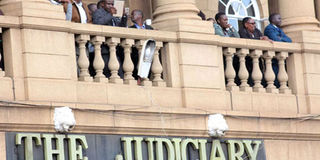The grim history of presidential petitions in Kenya

The Judiciary building in Nairobi. The Supreme Court, under the new Constitution, now handles presidential petitions. PHOTO | FILE | NATION MEDIA GROUP
What you need to know:
When the opposition was defeated by President Daniel arap Moi in 1992, a total of six petitions were filed at the High Court, but all of them, apart from the one were thrown out on procedural grounds.
President Moi challenged the validity of Mr Matiba’s petition by arguing that it was signed by his wife Edith who held Mr Matiba’s Power of Attorney.
Mr Matiba went to court alleging massive rigging of the election by ballot stuffing.
It’s easier to remove a sitting president through the ballot than through a petition — if the Kenyan experience is anything to go by.
Kenya has had various presidential petitions challenging an election since it held the multi-party election of 1992 and all of them have been thrown out by the courts on technicalities.
When the opposition was defeated by President Daniel arap Moi in 1992, a total of six petitions were filed at the High Court, but all of them, apart from the one by Kenneth Matiba, were thrown out on procedural grounds.
Mr Matiba went to court alleging massive rigging of the election by ballot stuffing.
But before the case was heard President Moi challenged the validity of Mr Matiba’s petition by arguing that it was signed by his wife Edith who held Mr Matiba’s Power of Attorney.
SIGN PETITION
Mr Matiba could not sign the petition since he had lost the use of his right hand and could not read as a result of a stroke he suffered in Kamiti Prison, where he was detained without trial by President Moi for calling for the re-introduction of multi-party politics.
Mr Moi’s preliminary objection before the High Court was ruled out, and he filed a Notice of Appeal in the Court of Appeal against the High Court’s decision.
It was a first, since petition court’s decisions at that time, were deemed final, according to Section 44 (5) at the time, which stated that “the determination of the ... election court of any question under the section whether interlocutory or final shall not be subject to appeal.”
When the matter of the signature was heard, the High Court reasoned that the law was clear that Mr Matiba ought to have signed the petition “in person” and that ended his petition.
HARUN MWAU
There was another petition by businessman John Harun Mwau — who vied for the presidency in 1992 and who told the court that he was the only validly nominated candidate since all the other candidates did not present the list of supporters nominating them in the ‘right paper’.
Mr Mwau, who got only 6,499 votes, wanted to be declared president on grounds that the law specified that the paper should be a foolscap of 216mm x 343mm, while all the others presented an A4 paper of 21cm × 29.7cm. The court ruled that “ingenious though this argument may be, it holds no water …”
The next serious presidential petition emanated from the 1997 election, which had among others Mwai Kibaki, Kijana Wamalwa and Raila Odinga.
After splitting their votes, the opposition failed to unseat President Moi, who garnered 2.5 million votes compared to his main challenger Mr Kibaki who received 1.9 million votes.
RAISED ISSUES
Mr Kibaki challenged the results in court and raised issues regarding “free and fair” doctrine of the electoral process.
But before the case could be heard, President Moi argued that he had not been personally served by the petitioner according to the National Assembly and Presidential Elections Act.
Prior to the 1997 elections, the Act had been amended by Act No. 10 of 1997, which provided that a petition questioning the validity of an election had to be served within 28 days of the election results’ publication. Mr Kibaki argued that it was impossible for the process servers to serve Mr Moi inside State House and Mr Moi had no incentive to let them in.
The court ruled that since the Legislature had decreed that “service of election petitions must be personal, the court must enforce the law”.
Kenya history academics Dr David Throup and Prof Charles Hornsby later wrote that “like water off a duck’s back, Mr Moi was able to brush off the petition”.
INVALIDATE RESULTS
The next three petitions followed the 2013 election of President Uhuru Kenyatta. The first was filed by Mr Raila Odinga and sought to invalidate the results of the presidential election, alleging that massive electoral fraud and malpractices occurred.
The second sought to determine what constituted a rejected vote, and whether rejected (spoilt) votes should have been counted when determining the total number of votes cast.
This was filed by Dennis Itumbi, Moses Kuria and Florence Sergon. The third petition sought to invalidate the results of the election based on the fact that there were numerous irregularities in voter registration, electronic voter identification and tallying. It was filed by the Africa Centre for Open Governance (Africog).
SUPREME COURT
The Supreme Court, which under the new Constitution was now handling presidential petitions, first knocked out 800 pages of Odinga’s filings and evidence before finally dismissing the case.
In the ruling rejecting the evidence read by Justice Philip Tunoi, the court stated that accepting the affidavits, and by extension, the new evidence would prejudice the respondents, Issack Hassan, the IEBC, Uhuru Kenyatta and William Ruto.
In the rejected evidence, the team of experts had planned to argue that about 267,798 more votes were cast for the presidential election than for the gubernatorial election.
But it agreed that rejected ballot papers are invalid and cannot be included while tallying results.




